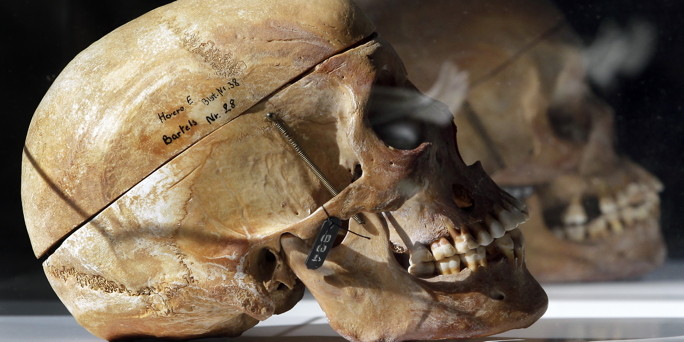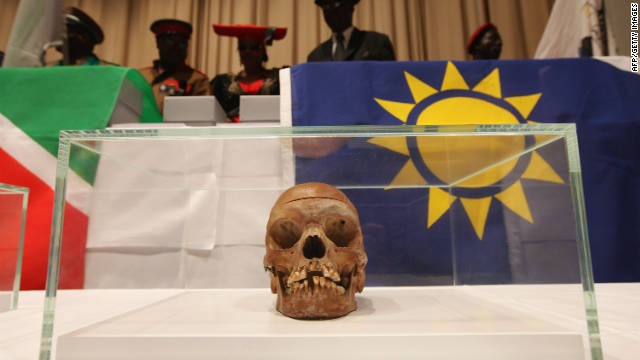
Sick, dead, hanged man: The origin of the skull in the Freiburg University cellars is grim. But justifies this silence and inaction? Photo: Thomas Kunz
Skeletons in the closet
Skeletons in the closet
As reported by The Badische-Zeitung, written by Heiko Wegmann, on 14 November 2009 -- The Freiburg University held a macabre heritage: skulls from colonial times. With the return she is in no hurry.
At first glance, the long shelves look harmless, standing in a basement of the University of Freiburg, equipped with clean white boxes. However, in layered them a macabre legacy: 1600 human skulls. Enter the name Alexander Ecker Collection. Many visitors do not find their way in this cool, bright yellow tiled room in the college building II. Before the new boxes were purchased, you probably had to hold your breath, because most of the skull were just around openly. Some hang list, some are labeled by hand. Among them are also twelve skulls from the former colony of German Southwest Africa, now Namibia, which were obtained during the German colonial period (1884-1919). Last year they were - in addition to 47 skulls from South Africa, the store in the Medical Historical Museum of the Charité in Berlin - a topic ARD report, the thoughtfulness, amazement and consternation caused in Germany and Namibia.
"After the article was sent," says the Namibian ambassador to Germany, "assured the Executive Board of the Charité, to have initiated its own investigation to determine the origin of the skull in its collection." His authority had achieved protests and solidarity of spectators and some German non-governmental organizations. "This," said the diplomat, "indignation was expressed particularly about the spread of this well known in Germany for some people matter."


In Namibia itself triggered the revelations "shock and disbelief" from themselves Gertze recalls. In October 2008, the Herero and Nama traditional leaders turned to their government. You should ask the German government to return the skull and the transfer of all associated costs. The Namibian government made the claim as its own, set up a committee and made contact with the German government. And since then? According to the ambassador, the Foreign Office while supporting the return, but would have taken different from the Charité, neither the University of Freiburg, other institutions concerned with the Embassy contact. "How does the process of making the remaining human remains here in the archives nationwide locate will go depends of course also very critical of the willingness of the other German institutions for cooperation from."
Although the University of Freiburg, 2004, on the initiative of its archive manager Dieter Speck pulled himself together after decades of silence and repression to a new attitude and decided that it was in principle in ill-gotten collection pieces ready to redemptions - on request and on an individual basis. On returns, it did not come so far, however. In the case of Namibia became involved about the Freiburg Peace Forum and the colonial history freiburg-postkolonial.de initiative and asked the university to ensure a dignified repatriation to Namibia. But so far, the University insists rather formalistic it, it needed an official request from the Namibian embassy, instead of making itself known university itself.

Spokeswoman Eva Opitz announced now at least on questions of BZ to the elucidation of the origin and identification of the skulls from Namibia as well as the larger number of Australian skulls in the Uni-shelves should be operated with a Volontariats- or PhD position. Australia had already in the 1990s - initially unsuccessful - efforts to the identification of human remains in Freiburg collections. Sweden, Great Britain and other countries have meanwhile returned to Australia skull in recent years, and we ask that Australia remains from Germany.
In Namibia now came again moving in the matter. Two representatives of affected groups gave the government a petition. Chief Dawid Frederick for the Nama and the Paramount Chief of the Herero, Kuaima Riruako, calling it again to return the skull. The Federal Republic was to give accurate information about their origin, age and sex, and explain what was done with them. Riruako said that about 60 skulls should not be as announced by the government buried in the national "Heroes Acre", but exhibited in a historic Genocide Museum. The MPs Ida Hoffmann announced that a delegation of the two groups will before traveling to Germany to perform traditional rituals honoring the dead. The German Embassy in Namibia stated that they support the petition, have the Charité and the University of Freiburg notified by letter and asked them to contact the Namibian Embassy in Berlin. A Freiburger response is still there.

Given the "skeletons in the closet of the University", the criticism focused on two points: the "racial-scientific" goals of the skull collector and former methods of obtaining the desired "human material". In various anthropological and anatomical collections store in Germany alone, tens of thousands of skulls and other human remains of all kinds of people. Although much of it comes from Germany itself, but was also collected more systematically around the world. The researchers wanted to create the 'Archives of the races ", especially the" endangered "breeds build, in order to draw conclusions on the history of mankind. In the anthropometry constantly surveying new methods were developed to classify "races" and to a hierarchy. And some researchers thought they could infer from the skull shape on mental properties.
That the "white race" is the highest stage of development, one of the basic assumptions of most previous anthropologists. Made outstanding contribution to the radicalization of scientific racism and its subsequent importance to the Nazis has Freiburg anthropo-loge and eugenicist Eugen Fischer (1874-1967). He campaigned as against "race-mixing go" because they had the genetic descent of the German people to the episode.
Against this background is not surprising that the buyer of the research subjects in the colonies vorgingen little squeamish. Adventurers, scientists, merchants and soldiers tipped over decades the University archives, and many a private collection. The expedition of the Duke Adolf Friedrich of Mecklenburg, after Eastern and Central Africa surveyed in 1907/08 fewer than 4,500 people - partly against the resistance - and took over 1,000 human skulls to Berlin. The skull store today, probably in New York Natural History Museum.

The Freiburg Alexander Ecker Skull collection dates back to the year 1810, when an African in Freiburg died of tuberculosis. His skull made with so-called Chinese-skulls the basis of 1850 by its namesake, the Freiburg anatomist and anthropologist Alexander Ecker (1816-1887), established collection. Eugen Fischer was personally responsible for the collection from 1900 to 1927. He had them sent numerous skull and soft tissues of the German colonies, including three conserved heads of just executed from the German South Seas. But he also laid hands on himself in what was then German South West Africa. In 1908 he was near Swakopmund graves of Topnaar Nama open and stole their corpses.
But even more cruel methods as grave desecrations were used. During the genocidal colonial war of the Germans against the Herero and Nama from 1904 to 1907 boxes were of the "protection force" sent with Herero skulls at the Pathological Institute in Berlin, where they were to be used for scientific measurements. "The skull, which are exempt from Herero women by broken glass from the meat and ready for dispatch comes from suspended or fallen Hereros," wrote an officer of the German troops 1907th

Anatomical studies of race "Hottentottenköpfen" from prison camps took also a lecturer in Berlin, Paul Barthel. The whereabouts of these war victims skull is not released. If they are available, they could have spread to different places due to the exchange practice between collections. Whether skull of the Charité or the plug-collection of Genocide victims originate, is unknown. Most collections suffer from the fact that precise origin provisions - after two world wars with lost documents and various surroundings - are only possible with expensive research. In Freiburg, the student Daniel Möller has important preliminary work done this last year with the collection and systematic thesis.
Right here see critics as the colonial historian Joachim Zeller an obligation on the German side. The collections would have to make itself publicly, what they have and not wait for requests. The affected former colonial countries were also hardly in the position to make these searches yourself. Zeller already tried in the early 1990s for reconnaissance. At that time he was still fobbed off by the Berlin archives, today the Charité is ready to returns. Last year, she has an agreement with Australia closed, return identified Aboriginal skull for a dignified burial. A model for Freiburg.
The official dealing with the grim scientific heritage acts now widely coyly. However, evidence was also found that there are still scientists in Germany who want to continue with the skull research. So it says on the website of the Museum of Ethnology in Dresden, which has a huge collection of skulls: "The later collected in ethnographically oriented museum extensive skull series, skeletons, plaster casts and hair samples of non-European populations today are scientifically invaluable material." [source: http://www.badische-zeitung.de/freiburg/leichen-im-keller--22379653.html]


No comments:
Post a Comment